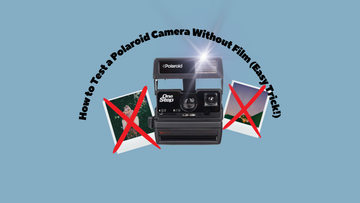
Introduction
As a passionate instant photography enthusiast, I'm always eager to share my knowledge and tips with fellow Polaroid camera owners. In this comprehensive blog post, I'll be revealing a simple yet effective trick to test your Polaroid camera's functionality without wasting a single film pack. Whether you've just acquired a vintage Polaroid 636 Close Up or are troubleshooting an older model, this method will help you ensure your camera is in working order before you start snapping away.
Polaroid cameras have a special charm that digital photography simply can't replicate. The anticipation of waiting for your image to develop, the unique aesthetic, and the tactile experience of holding a physical print - these are all part of the allure of instant film. However, before you can fully immerse yourself in the joys of Polaroid photography, it's important to make sure your camera is in tip-top shape. That's where this easy testing trick comes in handy.
In this article, I'll guide you through the step-by-step process of testing your Polaroid camera without film, covering everything from loading the film cassette to checking the flash and ejection mechanism. I'll also provide some additional tips and insights to help you get the most out of your vintage instant camera. So, let's dive in and unlock the secrets of Polaroid camera testing!
Preparing for the Test
The first step in testing your Polaroid camera without film is to gather the necessary materials. The key item you'll need is an empty film pack. This can be a used film pack that you've already exhausted, or you can purchase a dedicated empty pack for this purpose.
If you don't have an empty film pack on hand, you can also use a film cassette filled with already used pictures and a dark slide to cover the top. The dark slide is essential to prevent any light from entering the camera and exposing the film.
Once you have your film pack or cassette ready, it's time to load it into your Polaroid camera. This process is similar to loading a regular film pack, but with a few important differences. Let's walk through the steps:
- Locate the film door on your Polaroid camera and open it gently.
- Insert the empty film pack or the film cassette with the dark slide into the camera, making sure it's properly aligned and secured.
- Close the film door, ensuring it clicks into place.
- If your camera has a film counter, it may not accurately display the number of exposures remaining, as it's designed to work with a full film pack. Don't worry about this - the counter is not essential for the testing process.
With the film pack or cassette loaded, you're now ready to begin testing your Polaroid camera's functionality. Remember, this method won't allow you to test the camera's exposure accuracy, as that can only be done with actual film. However, you'll be able to check a wide range of other important features.
Checking the Camera's Basic Functions
Now that your Polaroid camera is loaded with the empty film pack or cassette, it's time to put it through its paces. Here are the key functions you'll want to test:
Shutter Release
The first and most crucial test is to check the shutter release button. Press the button firmly and listen for the characteristic sound of the shutter opening and closing. This ensures that the shutter mechanism is functioning correctly.
Film Ejection
Next, observe what happens when you press the shutter release button. The camera should eject the film pack or cassette, just as it would with a regular film pack. This tests the film ejection mechanism, which is essential for the smooth operation of your Polaroid camera.
Flash Operation
If your Polaroid camera has a built-in flash, now is the time to test it. Activate the flash and press the shutter release button. You should see the flash firing, indicating that the flash unit is working as intended.
It's worth noting that the flash test may not be as accurate as using a real film pack, as the empty pack or cassette won't provide the same level of resistance as a full pack. However, this test will still give you a good indication of whether the flash is firing properly.
Viewfinder and Focusing
Take a moment to look through the viewfinder and check that it's providing a clear, unobstructed view of the scene. This ensures that the viewfinder is functioning correctly and that you'll be able to frame your shots accurately.
If your Polaroid camera has a focusing mechanism, such as the close-up lens on the Polaroid 636 Close Up, test it by adjusting the focus and observing the changes in the viewfinder. This will help you confirm that the focusing system is working as expected.
Battery Check
Polaroid cameras often rely on batteries to power their various functions, such as the flash and electronic shutter. While you won't be able to test the camera's battery life with this method, you can check that the battery compartment is accessible and that the camera powers on when the batteries are installed.
If your camera doesn't power on or the battery compartment seems damaged, it's a good indication that you may need to replace the batteries or address any underlying issues before proceeding with further testing.
Advanced Testing Techniques
Once you've completed the basic functionality checks, you can delve deeper into more advanced testing techniques to ensure your Polaroid camera is in top condition. These additional tests will help you identify any potential issues or areas that may require further attention.
Exposure Simulation
While you can't test the camera's exposure accuracy without actual film, you can simulate the exposure process to some degree. With the empty film pack or cassette loaded, try taking a few test shots in different lighting conditions. Observe the camera's behavior, such as the shutter speed, aperture, and any exposure-related indicators.
This simulation can provide valuable insights into the camera's exposure system, even if you can't see the final results on film. Pay attention to any inconsistencies or unusual behavior, as these may indicate issues that need to be addressed.
Lens and Optics Inspection
Carefully examine the camera's lens and any other optical components, such as the viewfinder. Look for signs of scratches, haze, or other damage that could affect image quality. If you notice any issues, consider having the camera serviced by a professional before using it with film.
Additionally, you can test the lens's focusing capabilities by placing the camera on a stable surface and focusing on a distant object. Observe the sharpness of the image in the viewfinder as you adjust the focus.
Mechanical Inspection
Take a close look at the camera's overall mechanical condition. Check for any loose or worn parts, such as the film door hinges, film advance mechanism, or other moving components. Gently manipulate these elements to ensure they're functioning smoothly and without any excessive play or resistance.
If you notice any concerning issues, such as sticking parts or excessive wear, it's best to have the camera serviced by a qualified technician before attempting to use it with film. Trying to force a malfunctioning camera can lead to further damage and potentially ruin your film.
Troubleshooting and Maintenance
If your Polaroid camera doesn't pass one or more of the tests outlined above, don't worry - there are often simple solutions to common issues. Here are some troubleshooting tips and maintenance suggestions to help you get your camera back in working order:
Cleaning and Lubrication
- Gently clean the camera's exterior and interior components with a soft, lint-free cloth to remove any dust or debris.
- Apply a small amount of camera-safe lubricant to any moving parts, such as the film advance mechanism or shutter release, to ensure smooth operation.
- Avoid using harsh chemicals or abrasives, as these can damage the camera's delicate components.
Battery Replacement
- If the camera doesn't power on or the battery compartment is damaged, try replacing the batteries with fresh, high-quality cells.
- Consult your camera's manual or manufacturer's recommendations to ensure you're using the correct battery type and configuration.
Mechanical Adjustments
- If you notice any loose or sticking parts, gently tighten or adjust them, taking care not to over-tighten or force the mechanism.
- For more complex mechanical issues, it's best to seek the assistance of a qualified camera repair technician to avoid further damage.
Lens and Optics Maintenance
- Carefully clean the camera's lens and any other optical components using a soft, microfiber cloth and a specialized lens cleaning solution.
- Avoid touching the lens surface directly with your fingers, as this can leave behind oils and smudges that can affect image quality.
- If you notice any significant damage or deterioration to the lens or other optical components, consider having the camera serviced by a professional.
Conclusion
By following the steps outlined in this blog post, you now have a reliable method to test your Polaroid camera's functionality without wasting any precious film. Whether you're a seasoned Polaroid enthusiast or a newcomer to the world of instant photography, this easy trick will help you ensure your camera is in top condition before you start capturing those one-of-a-kind Polaroid moments.
Remember, while this testing method can't replace the ultimate test of using actual film, it's an invaluable tool for troubleshooting and maintaining your Polaroid camera. By taking the time to perform these checks, you'll be able to identify and address any issues before they become more serious problems, ultimately enhancing your overall Polaroid photography experience.
So, what are you waiting for? Grab an empty film pack or cassette, load up your Polaroid camera, and let's put it through its paces! And don't forget to check out our other Polaroid camera tutorials and resources to further expand your instant photography knowledge. Happy testing, and happy shooting!




